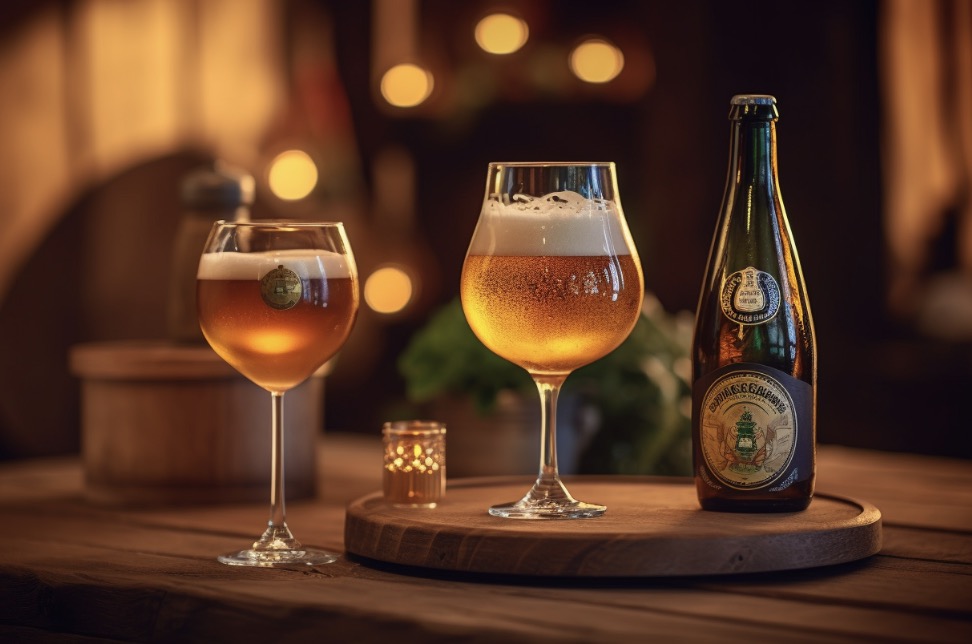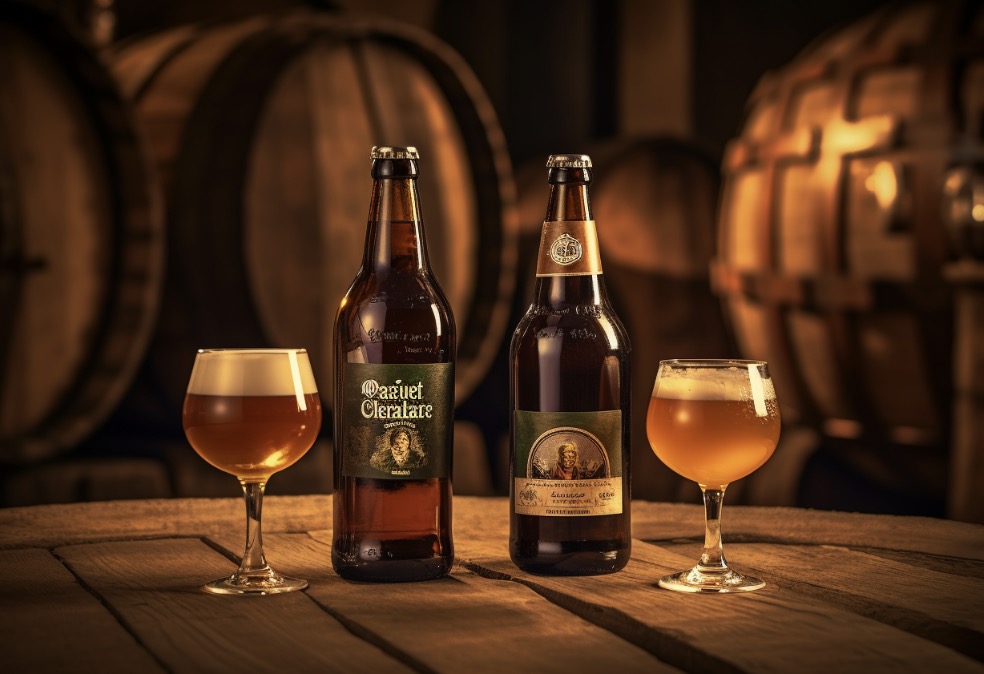Belgium is a country renowned for its rich beer culture, with a history of brewing that dates back to the Middle Ages. Among the many unique and diverse styles of Belgian beer, lambic and gueuze stand out as two of the most distinctive and intriguing.
These sour, wild-fermented beers are cherished by beer enthusiasts worldwide for their complex flavors, mysterious origins, and intriguing brewing methods.
The main difference between lambic and gueuze is that lambic is a spontaneously fermented beer that undergoes a single fermentation process, while gueuze is a blend of young and old lambics that undergoes a secondary fermentation in the bottle.
In this blog post, we will dive deep into the world of lambic and gueuze, exploring their history, brewing processes, characteristics, and the factors that make them unique among the vast array of beer styles. So grab a glass of your favorite sour beer and join us on this fascinating journey!
1. A Brief History of Lambic and Gueuze
Lambic and gueuze beers have a long and storied history, with roots that can be traced back to the early days of brewing in Belgium.

Here is a brief overview of their origins and development:
- Lambic is believed to have been first brewed in the late 16th or early 17th century, although some sources suggest it may have originated even earlier.
- Gueuze was first produced in the 19th century, as a way to make use of older, unsold lambic that had become too sour for most consumers’ tastes.
- The name “lambic” is thought to come from the town of Lembeek, which was once a major center of lambic production.
- The name “gueuze” is said to have been derived from the French word “gaz,” meaning gas or fizz, in reference to the effervescent character of the beer.
- Both lambic and gueuze are protected by European Union regulations, which dictate that they can only be produced in certain regions of Belgium, primarily in the Senne Valley near Brussels.
2. The Brewing Process: Spontaneous Fermentation
One of the key factors that sets lambic and gueuze apart from other beer styles is their unique brewing process, which relies on spontaneous fermentation rather than the addition of cultivated yeast strains. Here’s how it works:
- Lambic is brewed using a high proportion of unmalted wheat (typically around 30-40%), along with malted barley and aged hops.
- The wort (unfermented beer) is cooled in a large, shallow vessel called a coolship, which is usually located in the brewery’s attic or another well-ventilated area.
- As the wort cools, it is exposed to the wild yeasts and bacteria present in the air, which begin the fermentation process.
- Once sufficiently cooled, the wort is transferred to wooden barrels, where it will continue to ferment for anywhere from several months to several years.
- Gueuze is created by blending young (usually 1-year-old) and old (2-3 years old) lambics, which are then bottled and allowed to undergo a secondary fermentation.
3. The Role of Microorganisms
The complex flavors and aromas of lambic and gueuze are largely due to the wild yeasts and bacteria that are responsible for their fermentation. Some of the key microorganisms at play include:
- Saccharomyces cerevisiae: Often referred to as “brewer’s yeast,” this species is responsible for the primary fermentation of many types of beer but plays a less prominent role in lambic.
- Brettanomyces: This genus of wild yeast is responsible for the characteristic “funky” flavors often associated with lambic and gueuze, as well as their long fermentation times.
- Lactobacillus and Pediococcus: These lactic acid bacteria contribute to the sourness of lambic and gueuze, as well as their characteristic tangy, fruity flavors.
- Acetobacter: This genus of acetic acid bacteria is responsible for the production of acetic acid, which imparts a sharp, vinegar-like quality to some lambics and gueuzes.
4. Flavor Profiles: Tart, Funky, and Complex
Lambic and gueuze are known for their complex and often challenging flavor profiles, which can be both tart and funky. Here are some common descriptors for these unique beers:
- Lambic: Tart, sour, fruity (often with notes of green apple, lemon, or grapefruit), earthy, musty, barnyard, hay, horse blanket, and sometimes mildly acetic.
- Gueuze: Similar to lambic but often with a more pronounced sourness, greater complexity, and a lively carbonation that adds an effervescent, Champagne-like quality.
5. The Aromas: Earthy, Fruity, and Funky
The unique microorganisms responsible for fermenting lambic and gueuze also contribute to their distinctive aromas. Here’s what you might expect when taking a whiff of these beers:
- Lambic: Earthy, musty, barnyard, hay, horse blanket, and sometimes mildly acetic, along with fruity notes of green apple, lemon, or grapefruit.
- Gueuze: Similar to lambic but often with a more pronounced fruity character, as well as a greater complexity and depth of aroma.
6. Appearance: Hazy and Rustic
Lambic and gueuze beers often have a rustic, unpolished appearance that reflects their wild origins and traditional brewing methods. Here’s what to expect in terms of color and clarity:
- Lambic: Typically a hazy, pale gold to amber color, with little to no head (due to the lack of carbonation).
- Gueuze: Similar in color to lambic, but with a lively, effervescent head that can range from white to off-white.
7. Variations on a Theme: Fruit Lambics and Faro
In addition to traditional, unflavored lambic and gueuze, there are several variations on these styles that incorporate fruit or other flavorings. Some examples include:
- Fruit Lambics: These are lambics that have been aged with fruit, such as cherries (kriek), raspberries (framboise), or peaches (pêche), resulting in beers that are often more approachable and less challenging than their unflavored counterparts.
- Faro: This is a sweetened version of lambic, typically made by adding sugar, caramel, or other sweeteners to partially fermented lambic. Faro is often considered a more “entry-level” option for those new to the world of sour beers.
8. Serving and Pairing Suggestions
Lambic and gueuze are versatile beers that can be enjoyed on their own or paired with a variety of foods. Here are some serving and pairing suggestions to help you make the most of these unique brews:
- Serving temperature: Lambic and gueuze are best enjoyed at cellar temperature (around 50-55°F or 10-13°C), which allows their complex flavors and aromas to shine.
- Glassware: Traditional Belgian lambic and gueuze are often served in a stemmed, flute-like glass called a “stange” or “flute,” which helps to capture their effervescence and concentrate their aromas.
- Food pairings: Lambic and gueuze can be paired with a wide range of foods, from rich, creamy cheeses (such as Brie or Camembert) to tangy, vinegar-based dishes (such as salads or pickles). They also work well with spicy foods, as their acidity helps to cut through the heat.
Conclusion:
In conclusion, the difference between lambic and gueuze lies in their respective brewing processes and characteristics. Lambic is a spontaneously fermented beer that undergoes a single fermentation, while gueuze is a blend of young and old lambics that undergoes a secondary fermentation in the bottle. Both styles are known for their complex flavors, intriguing aromas, and unique brewing methods, which rely on wild yeasts and bacteria rather than cultivated strains. Here are ten key facts about lambic and gueuze to remember:
1. Lambic and gueuze are both Belgian sour beers that rely on spontaneous fermentation.
2. Lambic is a single-fermented beer, while gueuze is a blend of young and old lambics.
3. Both styles are brewed with a high proportion of unmalted wheat and aged hops.
4. Spontaneous fermentation occurs when the wort is exposed to wild yeasts and bacteria in the air.
5. Key microorganisms involved in the fermentation process include Saccharomyces cerevisiae, Brettanomyces, Lactobacillus, Pediococcus, and Acetobacter.
6. Lambic and gueuze are known for their tart, funky, and complex flavors.
7. Aromas of these beers are often described as earthy, fruity, and funky.
8. Lambic and gueuze typically have a hazy, rustic appearance.
9. Variations on these styles include fruit lambics and faro.
10. Lambic and gueuze can be enjoyed on their own or paired with a wide range of foods, from creamy cheeses to spicy dishes.
FAQs
What’s the difference between lambic and gueuze?
Lambic is a type of spontaneously fermented beer that is brewed in the Pajottenland region of Belgium, while gueuze is a blend of one, two, and three-year-old lambics that has undergone a secondary fermentation in the bottle.
What makes a beer a lambic?
A lambic is a type of beer that is spontaneously fermented using wild yeast and bacteria, typically in the region of Brussels, Belgium. It must be brewed with at least 30% wheat and aged in oak barrels for a minimum of one year. Additionally, lambics are often blended with fruit to create fruit lambics, such as cherry or raspberry lambics.
What are the different types of lambic?
There are several different types of lambic, including traditional, fruit, and blended lambics. Traditional lambics are unfruited and aged for at least one year, while fruit lambics are blended with fruit such as cherries, raspberries, or peaches. Blended lambics are a combination of traditional and fruit lambics.
What is the difference between lambic and sour beer?
Lambic is a type of sour beer that is spontaneously fermented with wild yeast and bacteria in the Senne River valley of Belgium, while sour beer refers to any beer that has intentionally been made sour through the addition of acidifying bacteria or wild yeast strains.
What are the characteristics of lambic?
Lambic is a traditional Belgian beer that is spontaneously fermented using wild yeast and bacteria. It is typically tart, sour, and fruity in flavor, with a dry finish and a low carbonation level. Lambic is often blended with fruit to create fruity variants such as kriek (cherry) and framboise (raspberry).
What is the difference between Gose and gueuze?
Gose is a sour, salty German beer style that typically includes coriander and wheat, while gueuze is a Belgian beer style that is a blend of young and old lambic beers, resulting in a tart, complex flavor profile.




